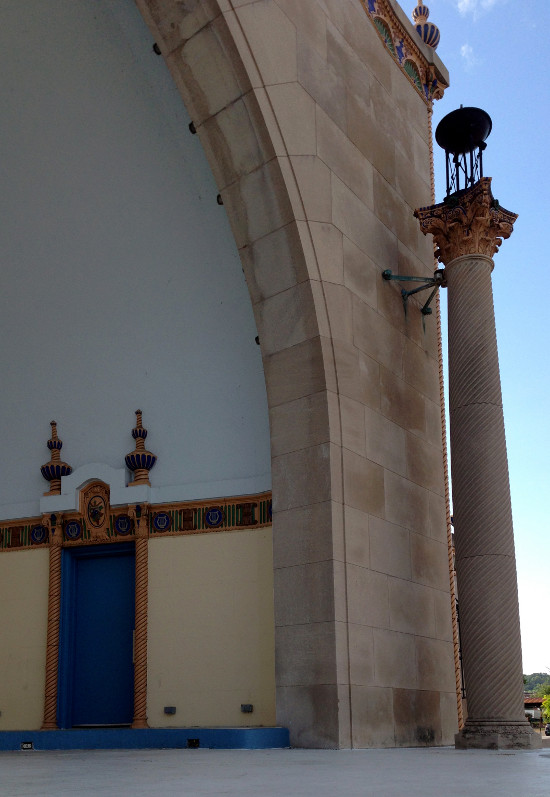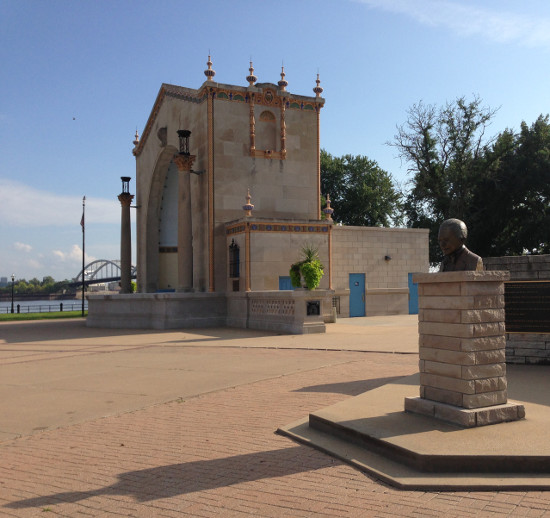
Fifty years ago - on August 23, 1963 - approximately 2,000 people gathered at the LeClaire Park bandshell for a civil-rights rally that served as a warm-up for the national March on Washington. Twenty-eight local delegates who would participate in the historic march were introduced. They would hear Martin Luther King Jr. deliver his "I Have a Dream" speech in the nation's capital five days later.
This was by no means the only rally at the bandshell. George W. Bush, for example, gave a campaign speech on its stage in 2004. Barack Obama spoke there three years later.
The bandshell has also served as center stage for numerous annual events -including the Mississippi Valley Blues Festival, River Roots Live, the Bix Beiderbecke Memorial Jazz Festival, and the Quad City Symphony Orchestra's Riverfront Pops concert. Past performers on the stage include Greg Brown, Albert Collins, Blue Öyster Cult, Buddy Guy, Little Feat, Los Lobos, The Marshall Tucker Band, and - this past weekend - the Wallflowers.
The bandshell's official name is the W.D. Petersen Memorial Music Pavilion. It was built in 1924 as a memorial to his daughter Wilma, who had died the previous year at the age of 38. Petersen paid for the pavilion's construction himself.
The 40-foot-tall structure is a wonderful example of the Exotic Revival style popular in the 1920s. The pavilion has classical architectural elements such as its twin Corinthian columns, but it is the distinctive Middle Eastern ornamentation - including the minaret-like pinnacles - that sets it apart from other architectural structures in Davenport. Its design is striking. The bold blue and gold colors contrast beautifully with the neutral, light color of the stone.

To its north is a larger-than-life bronze bust of Bix Beiderbecke (1903-31), whose musical genius, life, and early death have inspired Hollywood and international films, novels, and biographies. Created by Ted McElhiney in 1979, the bust has an unassuming demeanor: Bix has a shy smile, and his head is slightly tilted downward as if he is humbled by the literal wall of praise given to him on the three bronze plaques behind the sculpture.
Among the many statements on these plaques are a few words from jazz great Louis Armstrong: "I've heard a lot of cats try to play like Bix, but ain't nobody play like him yet." The inclusion of Armstrong's words is especially relevant to this location, as the two musicians first met at the Davenport levee in 1919. Beiderbecke was still a high-school student when he met Armstrong - who played cornet for a jazz orchestra on the Capitol, the largest of the Streckfus riverboats, while it was docked at the levee. As Armstrong recalled, "He'd come down to hear the bands, and then go home and practice what he heard. He and I became friends the first time we met. He was the type of youngster I admired all the way."
When the pavilion was built five years later, Beiderbecke was already a rising star -soon to be the soloist in the Paul Whiteman Orchestra, the most popular band in the '20s. In the same decade, Armstrong was making his most influential recordings. Both were transforming jazz.
It is fitting that the bust of Beiderbecke and the music pavilion are side-by-side: The interplay of cultures found in the roots of jazz is also found in the fusion of classical and Middle Eastern architectural styles of the 1924 pavilion. It is also fitting that the place where the two jazz legends first met- one white and the other African-American - would later be the site of a civil-rights gathering associated with Marin Luther King's words of equality and brotherhood.

Bruce Walters is a professor of art at Western Illinois University.
This is part of an occasional series on the history of public art in the Quad Cities. If there's a piece of public art that you'd like to learn more about, e-mail the location and a brief description to BD-Walters@wiu.edu.










